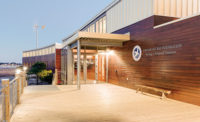ENR 2019 Top 25 Newsmakers
Moshe Safdie: Architect's Singapore 'Jewel' Redefined the Shopping Mall

Safdie’s extraordinary designs, such as Singapore’s Jewel Changi Airport, energize his collaborators, who then collectively overcome myriad complexities.
PHOTO COURTESY SAFDIE ARCHITECTS
Moshe Safdie calls himself a circumstantial architect. If his parents hadn’t immigrated to Canada from Israel, he would have been a farmer. But Canada’s harsh winters did not lend themselves to agriculture, so he sought a new path.
While in high school in Montreal, he took an aptitude test. The chart that resulted showed two lines crossing—mathematics and art. Based on that, Safdie was advised he was suitable for architecture—then a foreign concept to him.
Coming from a family of mostly merchants, “I knew nothing about architecture,” says Safdie, the 2015 American Institute of Architects Gold Medalist.
But he took the advice given and enrolled in McGill University’s school of architecture within the faculty of engineering. That meant a focus on engineering and construction. “I just loved it,” says the founder of Safdie Architects.
During his early years in Israel, though he knew nothing of architecture, Safdie was immersed in community, especially the Kibbutz collectives. That, combined with a scholarship during college to study housing all over the U.S., led him to write his thesis on Habitat, his new configuration for apartments, based on stacked and offset cubes. The thesis was well received, and Safdie ended up working on the Canadian Pavilion of Montreal’s World Exposition of 1967. In 1964, he started his firm to realize Habitat ’67, a 158-unit permanent residence for the exposition.
Habitat did not take off as he hoped, but it catapulted the young architect to prominence. That allowed Safdie, 81, to spend the last 52 years building community. His latest innovation is Singapore’s Jewel Changi Airport—a 135,700-sq-meter landside mall hidden below a five-story garden under glass, dominated by a dazzling record-tall indoor waterfall.
“It’s a new typology,” says Jaron Lubin, Safdie’s principal-in-charge for Jewel.
The design competition for the project called for airport facilities, retail and a central attraction for travelers and residents, such as an amusement park. Safdie cringed at the idea of something so dated.
Instead, he proposed visually separating the marketplace, with its signs, from the attraction. It took some doing to convince developer Capital Land, the airport authority and retailers to do something so unorthodox. And the need to integrate myriad systems made the project difficult. The 40-m-tall waterfall, with miles of hidden piping for water recirculation, was tough. But there were also commingled human and plant habitats and a long-spanning atrium roof, with an oculus that allows rainwater to supply the waterfall.
Safdie’s consultants went for it. “We really enjoyed working with Moshe and Jaron,” says Mark Fuller, chief excellence officer for WET Design, which delivered the waterfall, including its sound and light shows. “Architects like Moshe get the very best out of us. He’s like a kid opening a new toy, with eyes sparkling.”
Craig Schwitter, a structural partner with BuroHappold, Jewel’s roof designer, agrees: “They are very collaborative and have high levels of respect for their consultants. Moshe himself is very involved and amazing to work with.”
Jewel is a huge success. So much so that Safdie is in negotiations for another Jewel-like job.
That may be his next great challenge. He’s looking forward to it. With a staff of 100, nearly $10 billion worth of construction underway and his next-generation co-owners up to speed, Safdie expects to continue in high gear, as long as his health permits.
“It’s too much fun to stop,” he says.


-Janine-Pietz_ENRready.jpg?height=200&t=1737072241&width=200)

